Pyrrhonism
| Part ofa serieson |
| Pyrrhonism |
|---|
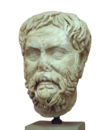 |
|
|
Pyrrhonismis an Ancient Greek school ofphilosophical skepticismwhich rejects dogma and advocates thesuspension of judgementover thetruthof all beliefs. It was founded byAenesidemusin the first century BCE, and said to have been inspired by the teachings ofPyrrhoandTimon of Phliusin the fourth century BCE.[1]Pyrrhonism is best known today through the surviving works ofSextus Empiricus,writing in the late second century or early third century CE.[2]The publication of Sextus' works in theRenaissanceignited arevival of interest in Skepticismand played a major role inReformationthought and the development ofearly modern philosophy.
History[edit]
Pyrrhonism is named afterPyrrho of Elis,a Greekphilosopherin the 4th century BCE who was credited by the later Pyrrhonists with forming the first comprehensive school ofskeptical thought.However, ancient testimony about the philosophical beliefs of the historical Pyrrho is minimal, and often contradictory:[1]his teachings were recorded by his studentTimon of Phlius,but those works have been lost, and only survive in fragments quoted by later authors, and based on testimonies of later authors such asCicero,Pyrrho's own philosophy as recorded by Timon may have been much more dogmatic than that of the later school who bore his name.[1]While Pyrrhonism would become the dominant form of skepticism in the early Roman period, in theHellenistic period,thePlatonic Academywas the primary advocate of skepticism until the mid-first century BCE,[3]when Pyrrhonism as a philosophical school was founded by Aenesidemus.[1][4]
Philosophy[edit]
The goal of Pyrrhonism isataraxia,[5]an untroubled and tranquil condition of soul that results from a suspension of judgement, a mental rest owing to which we neither deny nor affirm anything.
Pyrrhonists dispute that the dogmatists – which includes all of Pyrrhonism's rival philosophies – claim to have foundtruthregarding non-evident matters, and that these opinions about non-evident matters (i.e.,dogma) are what prevent one from attainingeudaimonia.For any of these dogmas, a Pyrrhonist makes arguments for and against such that the matter cannot be concluded, thussuspending judgement,and thereby inducing ataraxia.
Pyrrhonists can be subdivided into those who areephectic(engaged in suspension of judgment),aporetic(engaged in refutation)[6]orzetetic(engaged in seeking).[7]An ephectic merely suspends judgment on a matter, "balancing perceptions and thoughts against one another,"[8]It is a less aggressive form of skepticism, in that sometimes "suspension of judgment evidently just happens to the sceptic".[9]An aporetic skeptic, in contrast, works more actively towards their goal, engaging in the refutation of arguments in favor of various possible beliefs in order to reachaporia,an impasse, or state of perplexity,[10]which leads to suspension of judgement.[9]Finally, the zetetic claims to be continually searching for the truth but to have thus far been unable to find it, and thus continues to suspend belief while also searching for reason to cease the suspension of belief.
Modes[edit]
Although Pyrrhonism's objective is ataraxia, it is best known for itsepistemologicalarguments. The core practice is through setting argument against argument. To aid in this, the Pyrrhonist philosophersAenesidemusandAgrippadeveloped sets of stock arguments known as "modes" or "tropes."
The ten modes of Aenesidemus[edit]
Aenesidemusis considered the creator ofthe ten tropes of Aenesidemus(also known asthe ten modes of Aenesidemus)—although whether he invented thetropesor just systematized them from prior Pyrrhonist works is unknown. The tropes represent reasons for suspension of judgment. These are as follows:[11]
- Different animals manifest different modes of perception;
- Similar differences are seen among individual men;
- For the same man, information perceived with the senses is self-contradictory
- Furthermore, it varies from time to time with physical changes
- In addition, this data differs according to local relations
- Objects are known only indirectly through the medium of air, moisture, etc.
- These objects are in a condition of perpetual change in colour, temperature, size and motion
- All perceptions are relative and interact one upon another
- Our impressions become less critical through repetition and custom
- All men are brought up with different beliefs, under different laws and social conditions
According to Sextus, superordinate to these ten modes stand three other modes: that based on the subject who judges (modes 1, 2, 3 & 4), that based on the object judged (modes 7 & 10), that based on both subject who judges and object judged (modes 5, 6, 8 & 9), and superordinate to these three modes is the mode of relation.[12]
The five modes of Agrippa[edit]
These "tropes" or "modes" are given bySextus Empiricusin hisOutlines of Pyrrhonism.According to Sextus, they are attributed only "to the more recent skeptics" and it is byDiogenes Laërtiusthat we attribute them toAgrippa.[13]Thefive tropes of Agrippaare:
- Dissent– The uncertainty demonstrated by the differences of opinions among philosophers and people in general.
- Infinite regress– All proof rests on matters themselves in need of proof, and so on to infinity.
- Relation– All things are changed as their relations become changed, or, as we look upon them from different points of view.
- Assumption– The truth asserted is based on an unsupported assumption.
- Circularity– The truth asserted involves a circularity of proofs.
According to the mode deriving from dispute, we find that undecidable dissension about the matter proposed has come about both in ordinary life and among philosophers. Because of this we are not able to choose or to rule out anything, and we end up withsuspension of judgement.In the mode deriving from infinite regress, we say that what is brought forward as a source of conviction for the matter proposed itself needs another such source, which itself needs another, and soad infinitum,so that we have no point from which to begin to establish anything, and suspension of judgement follows. In the mode deriving from relativity, as we said above, the existing object appears to be such-and-such relative to the subject judging and to the things observed together with it, but we suspend judgement on what it is like in its nature. We have the mode from hypothesis when the Dogmatists, being thrown backad infinitum,begin from something which they do not establish but claim to assume simply and without proof in virtue of a concession. The reciprocal mode occurs when what ought to be confirmatory of the object under investigation needs to be made convincing by the object under investigation; then, being unable to take either in order to establish the other, we suspend judgement about both.[14]
With reference to these five tropes, that the first and third are a short summary of the earlier Ten Modes ofAenesidemus.[13]The three additional ones show a progress in the Pyrrhonist system, building upon the objections derived from the fallibility of sense and opinion to more abstract and metaphysical grounds. According toVictor Brochard"the five tropes can be regarded as the most radical and most precise formulation of skepticism that has ever been given. In a sense, they are still irresistible today."[15]
Criteria of action[edit]
Pyrrhonist decision making is made according to what the Pyrrhonists describe as thecriteria of actionholding to theappearances,without beliefs in accord with the ordinary regimen of life based on:
- the guidance of nature, by which we are naturally capable of sensation and thought
- the compulsion of thepassionsby which hunger drives us to food and thirst makes us drink
- the handing down of customs and laws by which we accept that piety in the conduct of life is good and impiety bad
- instruction intechne[16]
Skeptic sayings[edit]
The Pyrrhonists devised several sayings (Greek ΦΩΝΩΝ) to help practitioners bring their minds to suspend judgment.[17]Among these are:
- Not more, nothing more (a saying attributed toDemocritus[18])
- Non-assertion (aphasia)
- Perhaps, it is possible, maybe
- I withhold assent
- I determine nothing (Montaignecreated a variant of this as his own personal motto, "Que sais-je?" – "what do I know?" )
- Everything is indeterminate
- Everything isnon-apprehensible
- I do not apprehend
- To every argument an equal argument is opposed
Texts[edit]
Except for the works ofSextus Empiricus,the texts of ancient Pyrrhonism have been lost. There is a summary of thePyrrhonian DiscoursesbyAenesidemus,preserved byPhotius,and a brief summary of Pyrrho's teaching byAristocles,quoting Pyrrho's studentTimonpreserved byEusebius:
'The things themselves are equally indifferent, and unstable, and indeterminate, and therefore neither our senses nor our opinions are either true or false. For this reason then we must not trust them, but be without opinions, and without bias, and without wavering, saying of every single thing that it no more is than is not, or both is and is not, or neither is nor is not.[19]
Influence[edit]
In Ancient Greek philosophy[edit]
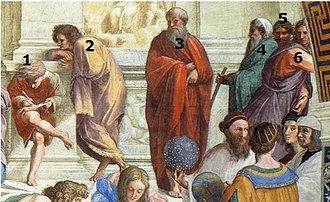
Pyrrhonism is often contrasted withAcademic skepticism,a similar but distinct form of Hellenistic philosophical skepticism.[9][20][21]While early Academic skepticism was influenced in part by Pyrrho,[22]it grew more and more dogmatic untilAenesidemusbroke with the Academics to revive Pyrrhonism in the first century BCE, denouncing the Academy as "Stoics fighting against Stoics.[23]"Some later Pyrrhonists, such asSextus Empiricus,go so far as to claim that Pyrrhonists are the only real skeptics, dividing all philosophy into the dogmatists, the Academics, and the skeptics.[20]Dogmatists claim to have knowledge, Academic skeptics claim thatknowledge is impossible,while Pyrrhonists assent to neither proposition, suspending judgment on both.[9][20][24]The second century Roman historianAulus Gelliusdescribes the distinction as "...the Academics apprehend (in some sense) the very fact that nothing can be apprehended, and they determine (in some sense) that nothing can be determined, whereas the Pyrrhonists assert that not even that seems to be true, since nothing seems to be true.[25][21]"
Sextus Empiricus also said that the Pyrrhonist school influenced and had substantial overlap with theEmpiric schoolof medicine, but that Pyrrhonism had more in common with theMethodic schoolin that it "follow[s] the appearances and take[s] from these whatever seems expedient."[26]
AlthoughJulian the Apostate[27]mentions that Pyrrhonism had died out at the time of his writings, other writers mention the existence of later Pyrrhonists. Pseudo-Clement, writing around the same time (c. 300-320 CE) mentions Pyrrhonists in hisHomilies[28]andAgathiaseven reports a Pyrrhonist named Uranius as late as the middle of the 6th century CE.[29]
Similarities between Pyrrhonism and Indian philosophy[edit]
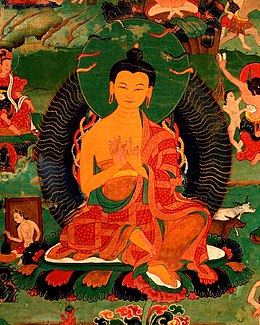
According to Diogenes Laërtius, Pyrrho was said to havetraveled to IndiawithAlexander the Great's army where Pyrrho was said to have studied with themagiand thegymnosophists,[30]and where he may have been influenced byBuddhistteachings,[31]most particularly thethree marks of existence.[32]Scholars who argue for such influence mention the fact that even the ancient author Diogenesis Laërtius states as much, when he wrote that Pyrrho “foregathered with the Indian Gymnosophists and with the Magi. This led him to adopt a most noble philosophy."[31]
According toChristopher I. Beckwith's analysis of the Aristocles Passage, adiaphora (anatta), astathmēta (dukkha), and anepikrita (anicca) are strikingly similar to the Buddhistthree marks of existence,[32]indicating that Pyrrho's teaching is based on Buddhism. Beckwith contends that the 18 months Pyrrho spent in India were long enough to learn a foreign language, and that the key innovative tenets of Pyrrho's skepticism were only found in Indian philosophy at the time and not in Greece.[33]Other similarities between Pyrrhonism and Buddhism include a version of thetetralemmaamong the Pyrrhonist maxims, and more significantly, the idea ofsuspension of judgementand how that can lead to peace and liberation, ataraxia in Pyrrhonism and nirvana in Buddhism.[34][35]
Furthermore, Buddhist philosopherJan Westerhoffsays "many of Nāgārjuna's arguments concerning causation bear strong similarities to classical sceptical arguments as presented in the third book of Sextus Empiricus'sOutlines of Pyrrhonism,"[36]andThomas McEvilleysuspects that Nagarjuna may have been influenced by Greek Pyrrhonist texts imported into India.[37]McEvilley argues for mutual iteration in theBuddhist logico-epistemological traditionsbetween Pyrrhonism andMadhyamika:
An extraordinary similarity, that has long been noticed, between Pyrrhonism and Mādhyamika is the formula known in connection with Buddhism as the fourfold negation (Catuṣkoṭi) and which in Pyrrhonic form might be called the fourfold indeterminacy.[38]
McEvilley also notes a correspondence between the Pyrrhonist and Madhyamaka views about truth, comparing Sextus' account[39]of two criteria regarding truth, one which judges between reality and unreality, and another which we use as a guide in everyday life. By the first criteria, nothing is either true or false, but by the second, information from the senses may be considered either true or false for practical purposes. As Edward Conze[40][verification needed]has noted, this is similar to the MadhyamikaTwo Truths doctrine,a distinction between "Absolute truth" (paramārthasatya), "the knowledge of the real as it is without any distortion,"[41]and "Truth so-called" (saṃvṛti satya), "truth as conventionally believed in common parlance.[41][42]
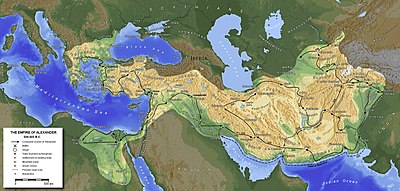
However, other scholars, such asStephen Batchelor[43]and Charles Goodman[44]question Beckwith's conclusions about the degree of Buddhist influence on Pyrrho. Conversely, while critical of Beckwith's ideas, Kuzminsky sees credibility in the hypothesis that Pyrrho was influenced by Buddhism, even if it cannot be safely ascertained with our current information.[31]
While discussing Christopher Beckwith's claims inGreek Buddha: Pyrrho's Encounter with Early Buddhism in Central Asia,Jerker Blomqvist states that:
On the other hand, certain elements that are generally regarded as essential features of Buddhism are entirely absent from ancient Pyrrhonism/scepticism. The concepts of good and bad karma must have been an impossibility in the Pyrrhonist universe, if "things" were ἀδιάφορα, 'without a logical self-identity', and, consequently, could not be differentiated from each other by labels such as 'good' and 'bad' or 'just' and 'unjust'. A doctrine of rebirth, reminiscent of the Buddhist one though favored by Plato and Pythagoras, was totally alien to the Pyrrhonists. The ἀταραξία, 'undisturbedness', that the Pyrrhonists promised their followers, may have a superficial resemblance to the Buddhist nirvana, but ἀταραξία, unlike nirvana, did not involve a liberation from a cycle of reincarnation; rather, it was a mode of life in this world, blessed with μετριοπάθεια, 'moderation of feeling' or 'moderate suffering', not with the absence of any variety of pain. Kuzminski, whom Beckwith hails as a precursor of his, had largely ignored the problem with this disparity between Buddhism and Pyrrhonism.[45]
Ajñana,which upheldradical skepticism,may have been a more powerful influence on Pyrrho than Buddhism. The Buddhists referred to Ajñana's adherents asAmarāvikkhepikasor "eel-wrigglers", due to their refusal to commit to a single doctrine.[46]Scholars includingBarua,Jayatilleke, and Flintoff, contend that Pyrrho was influenced by, or at the very least agreed with, Indian skepticism rather than Buddhism or Jainism, based on the fact that he valuedataraxia,which can be translated as "freedom from worry".[47][48][49]Jayatilleke, in particular, contends that Pyrrho may have been influenced by the first three schools of Ajñana, since they too valued freedom from worry.[50]
Modern[edit]
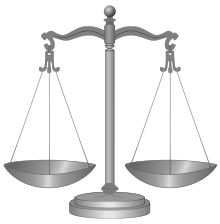
The recovery and publication of the works of Sextus Empiricus, particularly a widely influential translation byHenri Estiennepublished in 1562,[51]ignited arevival of interest in Pyrrhonism.[51]Philosophers of the time used his works to source their arguments on how to deal with the religious issues of their day. Major philosophers such asMichel de Montaigne,Marin Mersenne,andPierre Gassendilater drew on the model of Pyrrhonism outlined in Sextus Empiricus' works for their own arguments. This resurgence of Pyrrhonism has sometimes been called the beginning of modern philosophy.[51]Montaigneadopted the image of a balance scale for his motto,[52]which became a modern symbol of Pyrrhonism.[citation needed]It has also been suggested that Pyrrhonism provided the skeptical underpinnings thatRené Descartesdrew from in developing his influential method ofCartesian doubtand the associated turn ofearly modern philosophytowardsepistemology.[51]In the 18th century,David Humewas also considerably influenced by Pyrrhonism, using "Pyrrhonism" as a synonym for "skepticism."[53][better source needed].

Friedrich Nietzsche,however, criticized the "ephectics" of the Pyrrhonists as a flaw of early philosophers, who he characterized as "shy little blunderer[s] and milquetoast[s] with crooked legs" prone to overindulging "his doubting drive, his negating drive, his wait-and-see ('ephectic') drive, his analytical drive, his exploring, searching, venturing drive, his comparing, balancing drive, his will toneutralityandobjectivity,his will to everysine ira et studio:have we already grasped that for the longest time they all went against the first demands ofmoralityandconscience?"[54]
Contemporary[edit]
The term "neo-Pyrrhonism" is used to refer to modern Pyrrhonists such asBenson MatesandRobert Fogelin.[55][56]
See also[edit]
- Ajñana
- Apophasis
- Apophatic theology
- Cognitive closure (philosophy)
- Cratylism
- De Docta Ignorantia
- Defeatism
- Quietism
- Buddhism and the Roman world
- Greco-Buddhism
- Ancient Greece–Ancient India relations
- E-Prime
- Nassim Nicholas Taleb
- Trivialism
- The Hedgehog and the Fox
- List of unsolved problems in philosophy
Notes[edit]
- ^abcdLong, A. A. (12 September 1996).Hellenistic Philosophy: Stoics, Epicureans, Sceptics.Bloomsbury Academic. pp. 75–76.ISBN978-0-7156-1238-5.Retrieved15 January2023.
- ^Popkin, Richard Henry (2003).The history of scepticism: from Savonarola to Bayle.Popkin, Richard Henry, 1923- (Rev. and expanded ed.). Oxford: Oxford University Press.ISBN0198026714.OCLC65192690.
- ^Thorsrud, Harald (2009).Ancient scepticism.Stocksfield [U.K.]: Acumen. pp. 120–121.ISBN978-1-84465-409-3.OCLC715184861.
Pyrrhonism, in whatever form it might have taken after Timon's death in 230 BCE, was utterly neglected until Aenesidemus brought it back to public attention
- ^Stéphane Marchand, "Sextus Empiricus' Style Of Writing", inNew Essays on Ancient Pyrrhonism,p 113
- ^ Warren, James (2002).Epicurus and Democritean ethics: An archaeology of ataraxia.Cambridge University Press. p. I.ISBN0521813697.
- ^Pulleyn, William (1830).The Etymological Compendium, Or, Portfolio of Origins and Inventions.T. Tegg. pp.353.
- ^Bett, Richard Arnot Home (28 January 2010).The Cambridge Companion to Ancient Scepticism.Cambridge University Press. p. 212.
- ^Bett, Richard Arnot Home (28 January 2010).The Cambridge Companion to Ancient Scepticism.Cambridge University Press. p. 213.
- ^abcdKlein, Peter (2015)."Skepticism".Stanford Encyclopedia of Philosophy.Archivedfrom the original on 25 July 2018.Retrieved19 March2021.
- ^McInerny, Ralph (1969).A History of Western Philosophy, Volume 2.Aeterna Press. pp. Chp III. Skeptics and the New Academy, A. Pyrrho of Elis section, para 3–4.
- ^One or more of the preceding sentences incorporates text from a publication now in thepublic domain:Chisholm, Hugh,ed. (1911). "Aenesidemus".Encyclopædia Britannica.Vol. 1 (11th ed.). Cambridge University Press. pp. 257–258.
- ^Sextus Empiricus,Outlines of Pyrrhonism,Trans. R.G. Bury, Harvard University Press, Cambridge, Massachusetts, 1933, pp. 25–27
- ^abDiogenes Laërtius, ix.
- ^Sextus Empiricus,Pyrrhōneioi hypotypōseisi., from Annas, J.,Outlines of ScepticismCambridge University Press.(2000).
- ^Brochard, V.,The Greek Skeptics.
- ^Sextus Empiricus,Outlines of PyrrhonismBook I Chapter 11 Section 23
- ^Sextus EmpiricusOutlines of PyrrhonismBook I Chapter 18
- ^Sextus EmpiricusOutlines of PyrrhonismBook II Chapter 30
- ^Eusebius."Praeparatio Evangelica Book XIV".Tertullian Project.Retrieved27 January2023.
- ^abcSextus, Empiricus (1990).Outlines of pyrrhonism.Robert Gregg Bury. Buffalo, N.Y.: Prometheus Books.ISBN0-87975-597-0.OCLC23367477.
- ^abThorsrud, Harald (2009).Ancient scepticism.Stocksfield [U.K.]: Acumen.ISBN978-1-84465-409-3.OCLC715184861.
- ^Thorsrud, Harald (2009).Ancient scepticism.Stocksfield [U.K.]: Acumen. p. 45.ISBN978-1-84465-409-3.OCLC715184861.
- ^Thorsrud, Harald (2009).Ancient scepticism.Stocksfield [U.K.]: Acumen. pp. 102–103.ISBN978-1-84465-409-3.OCLC715184861.
Aenesidemus criticized his fellow Academics for being dogmatic...Aenesidemus committed his scepticism to writing probably some time in the early-to-mid first century BCE...leading Aenesidemus to dismiss them as "Stoics fighting against Stoics."
- ^Popkin, Richard (1995).The Cambridge dictionary of philosophy.Robert Audi. Cambridge. p. 741.ISBN0-521-40224-7.OCLC32272442.
{{cite book}}:CS1 maint: location missing publisher (link) - ^Gellius, Aulus (2008).Noctes Atticae.Josef Feix (3. Dr ed.). Paderborn: Schöningh.ISBN978-3-14-010714-3.OCLC635311697.
- ^Sextus Empiricus, Outlines of Pyrrhonism I.237, trans. Etheridge (Scepticism, Man, and God, Wesleyan University Press, 1964, p. 98).
- ^Epistleslxxxix 301C
- ^Pseudo-Clement,Homilies,13.7
- ^AgathiasII 29-32, cited in Jonathan Barnes,Mantissa2015 p. 652
- ^"Diogenes Laërtius,Lives of Eminent PhilosophersBook IX - Chapter 11. PYRRHO (c. 360-270 b.c.) ".www.perseus.tufts.edu.
- ^abcKuzminski, Adrian (2021).Pyrrhonian Buddhism: A Philosophical Reconstruction.Routledge.ISBN9781000350074.
- ^abBeckwith, Christopher I. (2015).Greek Buddha: Pyrrho's Encounter with Early Buddhism in Central Asia(PDF).Princeton University Press.p. 28.ISBN9781400866328.
- ^Beckwith, Christopher I. (2015).Greek Buddha: Pyrrho's Encounter with Early Buddhism in Central Asia.Princeton University Press.p. 221.ISBN9781400866328.
- ^Sextus Empricus,Outlines of PyrrhonismBook 1, Section 19
- ^Hanner, Oren.Buddhism and Scepticism: Historical, Philosophical and Comparative Perspectives.pp. 126–129.ISBN978-3-89733-518-9.
- ^Jan WesterhoffNagarjuna's Madhyamaka: A Philosophical IntroductionISBN01953849622009 p93
- ^Thomas McEvilley,The Shape of Ancient Thought2002 pp499-505
- ^McEvilley, Thomas (2002).The Shape of Ancient Thought.Allworth Communications.ISBN1-58115-203-5.,p.495
- ^Sextus Empiricus,Outlines of Pyrrhonism,II.14–18;Anthologia Palatina(Palatine Anthology), VII. 29–35, and elsewhere
- ^Conze 1959, pp. 140–141
- ^abConze (1959: p. 244)
- ^McEvilley, Thomas (2002).The Shape of Ancient Thought.Allworth Communications.ISBN1-58115-203-5.,p. 474
- ^Stephen Batchelor"Greek Buddha: Pyrrho's encounter with early Buddhism in central Asia",Contemporary Buddhism,2016, pp 195-215
- ^Charles Goodman, "Neither Scythian nor Greek: A Response to Beckwith's Greek Buddha and Kuzminski's" Early Buddhism Reconsidered "",Philosophy East and West,University of Hawai'i Press Volume 68, Number 3, July 2018 pp. 984-1006
- ^says, Unknown."Greek Buddha: Pyrrho's Encounter with Early Buddhism in Central Asia – Bryn Mawr Classical Review".
- ^Jayatilleke, K.N.Early Buddhist Theory of Knowledge.George Allen & Unwin Ltd., London, p. 122.
- ^Barua 1921,p. 299.
- ^Jayatilleke 1963,pp. 129–130.
- ^Flintoff 1980.
- ^Jayatilleke 1963,pp. 130.
- ^abcdPopkin, Richard Henry (2003).The History of Scepticism: from Savonarola to Bayle(Revised ed.). Oxford: Oxford University Press.ISBN9780198026716.OCLC65192690.
- ^Sarah Bakewell,How to Live: Or A Life of Montaigne in One Question and Twenty Attempts at an Answer2011 p 127ISBN1590514831
- ^Dialogues Concerning Natural Religion,page 7, section 23.
- ^Friedrich Nietzsche; Maudemarie Clark; Alan J. Swensen (1998).On the Genealogy of Morality.Hackett Publishing. p. 79.
- ^Michael Williams, "Fogelin's Neo-Pyrrhonism",International Journal of Philosophical StudiesVolume 7, Issue 2, 1999, p141
- ^Smith, Plínio Junqueira; Bueno, Otávio (7 May 2016). Zalta, Edward N. (ed.).Skepticism in Latin America.Metaphysics Research Lab, Stanford University – via Stanford Encyclopedia of Philosophy.
References[edit]
- Barua, Benimadhab (1921).A History of Pre-Buddhistic Indian Philosophy(1st ed.). London: University of Calcutta. p. 468.
- Flintoff, Everard (1980). "Pyrrho and India".Phronesis.25(1). Brill: 88–108.doi:10.1163/156852880X00052.JSTOR4182084.
- Jayatilleke, K.N. (1963).Early Buddhist Theory of Knowledge(PDF)(1st ed.). London: George Allen & Unwin Ltd. p. 524. Archived fromthe original(PDF)on 11 September 2015.
- Thorsrud, Harold."Ancient Greek Skepticism".Internet Encyclopedia of Philosophy.
- Vogt, Katja."Ancient Skepticism".InZalta, Edward N.(ed.).Stanford Encyclopedia of Philosophy.
External links[edit]
